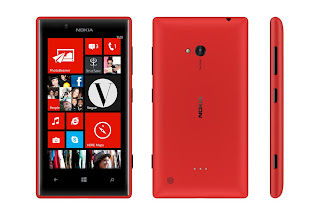Nokia's Lumia handsets are coming thick and fast. They all run on the Windows Phone 8 operating system and the 720 comes in the middle of the pack, with a midrange spec by Nokia standards, but attention to detail and a feast of add-ons nudges it closer to the high-end than many manufacturers.
It's on sale now for around £280.
Design
Whatever their price and spec, Nokia's Lumia handsets share a commitment to solid build quality and the 720 is no exception. The polycarbonate unibody design feels tough and absolutely without flex. While you can't open it to get at the battery, there are slots in the side and top for microSIM and microSD memory cards. Buttons on one side include volume rocker, power/sleep and camera shutter, with 3.5mm headphone jack and microUSB port on top and bottom respectively. At just 9mm thick it's easy to slip into the pocket and it's fairly lightweight too at 128g, certainly more so that its higher-specced (and considerably higher priced) cousin, the Lumia 925
Whatever their price and spec, Nokia's Lumia handsets share a commitment to solid build quality and the 720 is no exception. The polycarbonate unibody design feels tough and absolutely without flex. While you can't open it to get at the battery, there are slots in the side and top for microSIM and microSD memory cards. Buttons on one side include volume rocker, power/sleep and camera shutter, with 3.5mm headphone jack and microUSB port on top and bottom respectively. At just 9mm thick it's easy to slip into the pocket and it's fairly lightweight too at 128g, certainly more so that its higher-specced (and considerably higher priced) cousin, the Lumia 925
.
It's responsive too, and you can set the sensitivity to "high" which allows you to use it with gloves, something we've seen on other Lumia handsets as well as Samsung's Galaxy S4 high-ender.
Software and features
The Windows Phone 8 software takes a bit of getting used to after Android or iOS, but it's so simple, the learning curve is really very short. It's easy to move the tiles from the apps menu to your scrollable home page. It's easy to resize them as well, and active ones, such as your People tile that alternates pictures of your contacts in an ever-shifting mosaic, or the weather tile that gives constant climate updates, are welcome.
No, the Windows Marketplace doesn't bear comparison with Google Play or Apple's App Store, but it has many essentials like Facebook, Twitter, Spotify and Netflix, even if it too often gets frustrating when you can't find some other favourites. Still, it has 140,000 apps now and it's growing steadily -- it may be the last platform on developers' lists, but at least the apps are being created, eventually.
Performance
The dual-core 1GHz processor backed by 512MB RAM is distinctly mid-range these days, especially with many handsets now providing a full 1GB or more of RAM. But while it might feel a little underpowered on an Android handset, Windows' streamlined architecture means you don't really notice any slowdown in general use. Apps open smoothly, albeit just a wee bit sluggishly when compared to more powerful engines, as do web pages and HD games (not that you have a huge range to choose from on Windows) play smoothly. It delivered an AntuTu performance benchmark rating of 7,628, which puts it behind some dual-core handsets like the HTC One SV but ahead of others like the Sony Xperia T.
Nokia has an exemplary package of extras as standard, including HERE Maps with its range of views including standard, satellite, public transport and traffic maps. You can download maps and use them with HERE Drive turn-by-turn satnav, even when you don't have a Wi-Fi or network connection, all for free. You can even download the new City Lens app, which we recently saw demonstrated on the top-end Lumia 925. This shows local businesses and points of interest using augmented reality -- hold your phone's camera up and it will overlay details about what's nearby. Nokia Music is also a big plus, with free downloadable playlists of popular tunes.
Camera quality
The 6.7-megapixel camera is a step up from the 620's five-megapixel model and comes with Carl Zeiss Tessar lens, a good-sized F1.9 aperture, LED flash and autofocus. That's a pretty decent spec on its own and you can add further features thanks to Windows Lenses -- bits of downloadable software that add additional functionality such as Smart Shoot, which takes five rapid shots so you can choose the best one. Other Lenses include Panorama for wide-view shots, Cinemagraph, which allows you to add moving elements to still pictures, and Bing Vision, which lets you scan barcodes and QR codes as well as books, CDs and DVDs.
Picture quality is very good, easily up there with most eight-megapixel types, with sharp edges and accurate colours. The video camera made a decent show of itself too, recording 720p video at 30fps and the 1.3-megapixel camera on the performs well with Skype video calls in low light conditions.
There's 8GB of memory on board, which is a good start, but unlike many Windows handsets you can also add more via microSD card -- up to 64GB. This being Windows of course you also get 7GB of cloud storage free of charge via SkyDrive.
The good-sized 2,000mAh battery held up very well, delivering a good day-and-a-half of regular use.
Conclusion
The Nokia Lumia 720 is a solid mid-range phone but with better than expected build quality, a better than average camera and a good range of Nokia extras including HERE Maps and Drive satnav, plus Music and the Microsoft Office suite. You get a lot for your cash, and it's worth checking out if you've only been considering yet another Android handset.












.jpg)

.jpg)
.jpg)
Great Blog..Your Point Of View..is really good
ReplyDeleteWeb Designing Company
Web Development Company
Web Design Company